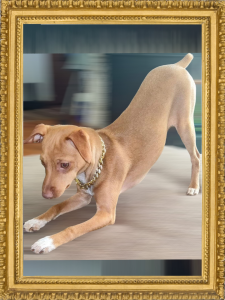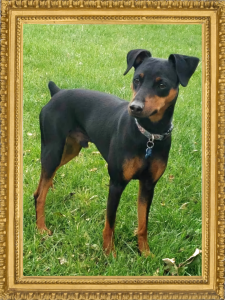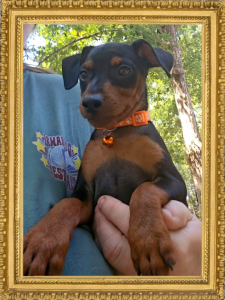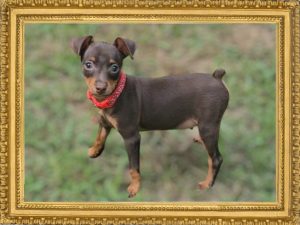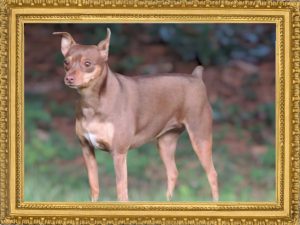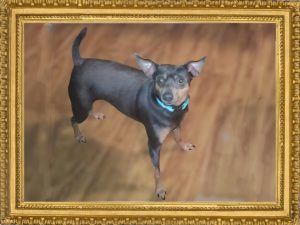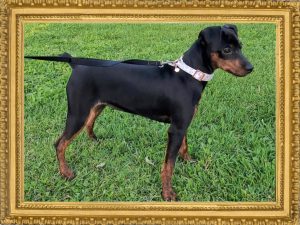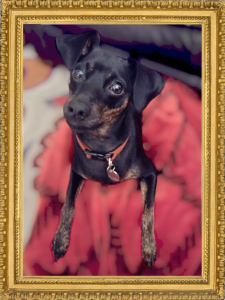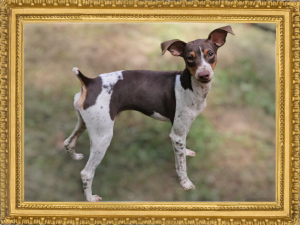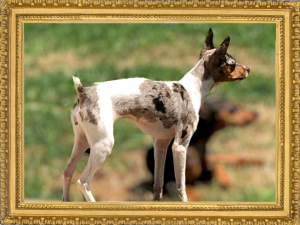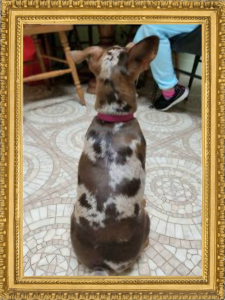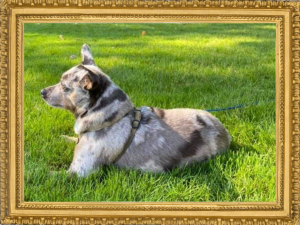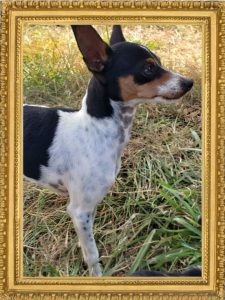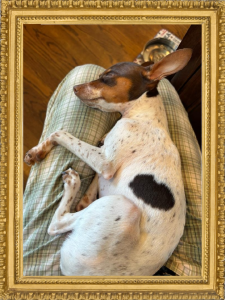Color and Pattern Descriptions
There are 9 acceptable colors in the purebred Miniature Pinscher and all of these colors plus Tan are acceptable colors in the Harlequin Pinscher and Min Pins out of Harlequin litters. Points on some colors can be Tan or Rust and counted as extra colors. There are NO patterns in the purebred Miniature Pinscher. However there are 3 basic and numerous combination patterns acceptable in the Harlequin Pinscher.
Description of Colors
Red
The Agouti gene is responsible for the production of the red coat color and the intensity of which it is expressed. In some forms, Red is incomplete dominant but it also can be recessive and be expressed in a variety of genotype code sequences. The nose, eye rim and paw pads are colored depending on their base genotype.
Stag Red and Red
Stag red, a form of sable using the genetic color code of Ay. It is expressed by covering the base color Red with darker intermingling hairs. If the base color is black then the hairs will be black. If the base color is brown, blue or fawn then the hairs will be base colored and labeled appropriately. Stag Red (black hairs), Chocolate Stag Red (brown hairs), Blue Stag Red (blue hairs) or Fawn (Isabella) Stag (fawn hairs).
At times a dogs coat will shown no darker intermingling hairs due to other gene factors and/or intensity genes. They are just RED and sometimes referred to as clear red. These dogs are labeled depending on the base colors they express in their nose, eye rim and paw pads. Black base = Red, Brown base = Red w/brown nose, Blue base = blue fawn, Fawn based = Tan.
Recessive Red
Recessive red is a phenomenon that happens when a dog receives 2 copies of the recessive “e” allele (e/e). Recessive red can be produced from any color and their base color will only be shown in the nose, eye rim and paw pad color. Their coat color cant vary greatly and include orange, yellow, ivory, cream and nearly white. Recessive reds are referred to as clear reds and labeled according to their base color NOT their coat color. Black = Clear Red, Brown = Clear Red w/ brown nose, Blue = Blue fawn, fawn = Tan.
**The recessive red gene will hide all colors and patterns. Caution must be taken if a recessive red dog is kept in a Harlequin Pinscher breeding program. Genetic testing is a MUST to know if the dog is genetically a merle or not.
Black and Tan (or Rust)
The Extension (E-locus) gene and the Dominant Black (K-locus) is responsible for the production of black and the intensity of which it is expressed. Black is dominant in nature. The nose, eye rim and paw pads MUST be black colored in the Miniature Pinscher. ONLY if a dog is a Harlequin Pinscher and is also expressing the merle pattern can they can be mottled.
**ALL Miniature Pinschers that are Black and tan MUST have clearly defined tan or rust points. ONLY if a dog is a Harlequin Pinscher and is also expressing the brindle pattern can they be covered or undefined.
Brown/Tan (or Rust)
The Brown (B-locus) gene is responsible for the brown and liver coat colors. Brown is recessive in nature and requires 2 copies of the gene to produce. The nose, eye rim and paw pads MUST be brown in the Miniature Pinscher. ONLY if a dog is a Harlequin Pinscher and is also expressing the merle pattern can they can be mottled.
**ALL Miniature Pinschers that are Brown and Tan MUST have clearly defined tan or rust points. ONLY if a dog is a Harlequin Pinscher and is also expressing the brindle pattern can they be covered or undefined.
Blue and Tan (or Rust), Fawn and Tan (or Rust), Blue Fawn (or Blue Stag Red) and Tan
The Dilute (D-locus) gene is responsible for the production of blue, fawn and tan (peachy) colored coats. The dilute gene is recessive in nature and 2 copies of the gene is required to produce. The color of a dogs coat is determined by their base color. Black Base = Blue, Brown Base = Fawn, Red Base = Fawn, Isabella or Tan, Stag Red Base = Blue Fawn or Blue Stag Red
The nose, eye rim and paw pads colors will be self colored depending on their coat color. Blue, Blue Fawn or Blue Stag Red = Blue (gray), Fawn, Isabella or Tan = Pink (light brown). They MUST be fully colored in the Miniature Pinscher. ONLY if a dog is a Harlequin Pinscher and is also expressing the merle pattern can they can be mottled.
**ALL Miniature Pinschers that are Blue and tan or Fawn and Tan MUST have clearly defined tan or rust points. ONLY if a dog is a Harlequin Pinscher and is also expressing the brindle pattern can they be covered or undefined. Blue Stag Red, Blue Fawn, Fawn (Isabella) or Tan colored dogs will NOT have points.
Description of Patterns
Merle
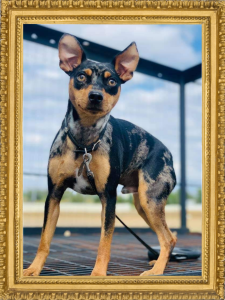 The Merle (M-locus) gene is a modifying gene that is responsible for the production of the fascinating and beautiful splotched and patched pattern in a dogs coat. The merle gene is a IS NOT A COLOR gene. It is a incomplete dominant gene in nature and only requires 1 copy to produce. The gene must also be expressed by one parent as it is not a carrying type gene. EITHER A PUP IS A MERLE OR IT ISN’T. It can affect all coat colors but is especially visible in black, brown, blue or fawn base colored dogs. Red based colors are not affected by the gene like the other colors. They do not have as pretty of a pattern and some are very hard to see, even at birth.
The Merle (M-locus) gene is a modifying gene that is responsible for the production of the fascinating and beautiful splotched and patched pattern in a dogs coat. The merle gene is a IS NOT A COLOR gene. It is a incomplete dominant gene in nature and only requires 1 copy to produce. The gene must also be expressed by one parent as it is not a carrying type gene. EITHER A PUP IS A MERLE OR IT ISN’T. It can affect all coat colors but is especially visible in black, brown, blue or fawn base colored dogs. Red based colors are not affected by the gene like the other colors. They do not have as pretty of a pattern and some are very hard to see, even at birth.
**Extreme caution and responsibility should be taken if a red based merle dog is used in a Harlequin Pinscher Breeding program.
The merle gene DOES NOT change the DNA genotype of a dogs coat color. ONLY the lighter color seen in a merle dogs coat is the merle pattern. The larger (more pronounced) and darker splotches or patches with in the coat is what determines the base color of the dogs coat.
Black Splotches = Black/Tan Merle
Blue Splotches = Blue/Tan MerleBlue Fawn Merle or Blue Stag Red Merle
Brown Splotches = Brown/Tan Merle or Red Merle w/brown nose
Fawn Splotches = Fawn/Tan Merle,Fawn (Isabella) Merle or Tan (peachy) Merle.
**A merle dog should NOT be paired with another merle dog for any reason at all. IMO, it is totally unethical to do so as the results can potentially produce double merle offspring. Merle is a semi-lethal gene in DOUBLE form. Known as Double Merle. It can cause death in utero or shortly after birth. If a pup survives, they can potentially have long term health issues, be deaf and/or blind.
**The merle gene is safe to pair with all colors,the Brindle pattern and the Piebald Pattern.
Brindle
Brindle is a allele that presents itself on the Dominant Black (K-locus) gene. Not much is know about the way the allele works. We do know that it is incomplete dominant in the Harlequin Pinscher as one copy of the gene must be expressed in order to produce brindle patterned offspring. We have only found that Recessive Red (e/e) colored dogs can carry the brindle gene, not express it in their coat and produce brindle offspring.
Brindle presents itself in a dogs coat by giving the coat a striped appearance. Brindle only affects the color red which includes ALL of the red based colored dogs and Tan (or Rust) Points!!
The intensity of the brindle gene varies and with dogs that have tan points it can appear as light as a single smudge spot in a tan point or as dark as covering the whole tan point making it early invisible. In red based colored dogs, the brindle gene can be one tiny spot or nearly the whole dog!
The color of the brindle pattern is determined by the color of the dogs coat.
Black/Tan or Stag Red = Brindle will be Black
Blue, Blue Stag Red or Blue Fawn = Brindle will be Blue (gray)
Brown/Tan, Chocolate Stag Red or Red w/Brown Nose = Brindle will be Brown
Fawn/Tan, Fawn (Isabella) or Tan (peachy) = Brindle will be Fawn
**The brindle pattern is safe to pair with all colors, its self, the brindle pattern and the merle pattern.
Piebald, Tuxedo and Tri

